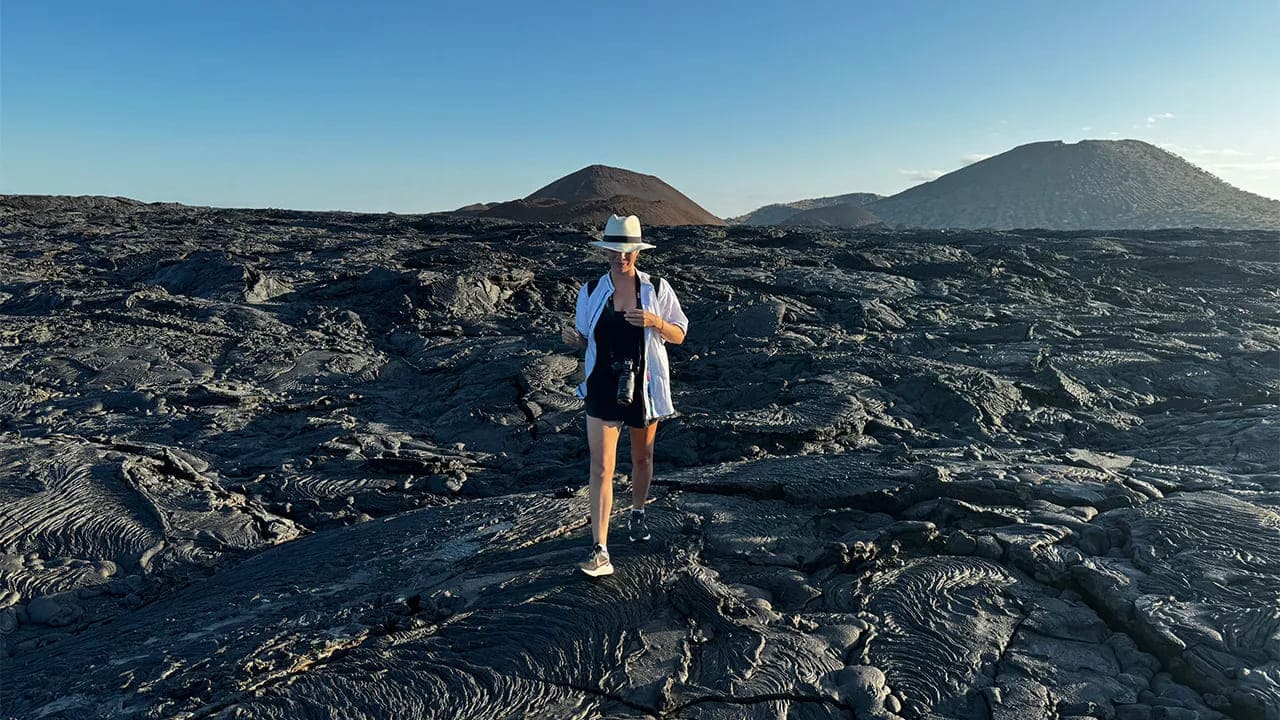
See wildlife like never before on a Galapagos Cruise | Travel News
Jenny Hewett describes how their guide, Darwin Alvarez, a figure who seems part-man, part-fish, explains that the gesture he is making is a signal for a great white shark, tracing the sign of the cross on his chest. Although said in jest, this remark stays with her as she plunges off the dinghy and into the dark waters of the Pacific Ocean.
As soon as she is submerged, she encounters a pod of spinner dolphins, just a few meters away, their grinning faces close by. The dolphins, ever-curious, approach her and then swim underneath, giving her a playful look. One dolphin, larger and more intimidating, almost makes her consider returning to the dinghy. Darwin then exclaims, “Wow, it’s a blacktip reef shark! A big one!” highlighting the ongoing drama of the Galápagos.
On just the third day of her expedition cruise through the eastern part of the protected Ecuadorian archipelago, Hewett has already experienced something extraordinary. The wildlife here, free from the usual threat of humans, is more relaxed than she has ever seen. From sunbathing yellow-and-red land iguanas to sea lions frolicking in turquoise bays and fluffy white great frigatebird chicks, the animals seem unfazed by human presence.

As her father, Kym, observes, binoculars aren’t even necessary due to the unique evolution of these isolated volcanic islands. The animals have lived without natural predators for millions of years until humans arrived over 450 years ago. Even now, Darwin describes them as “tame,” reflecting their docile nature.
Hewett notes that the way they explore this UNESCO-listed area is part of the experience. Their small cruise ship, accommodating just 16 people, contrasts sharply with the larger vessels permitted in the archipelago. Darwin emphasizes the advantages of small ships, saying, “There is no flexibility on a big ship. Small ships are the way to go.”
Throughout their trip, wildlife encounters are brief but remarkable. From golden rays gliding through the water and marine iguanas basking on rocks to waved albatrosses performing mating dances and sea turtles surveying the scene, every moment is extraordinary. Guides insist on keeping a 2-meter distance from wildlife, but sometimes the animals come closer. On one occasion, Darwin takes them to a secret cove on Gardner Island to swim with “kinda crazy” sea lions, where even her father joins in with playful antics. A few days later, they encounter hammerhead sharks in murky water off Genovesa Island.
The Galápagos offers a surprising ease compared to other expedition destinations like Antarctica. The well-organized tourism industry ensures smooth operations. Days on the Beluga, their small boat, begin with land expeditions, snorkeling, or kayaking, and continue with island excursions. Even in late May, with water temperatures around 18-20°C and pleasant weather at 20-26°C, the boat provides wetsuits and hot showers.

On land, they explore the misty highlands, meet giant Galápagos tortoises, and view the mummy of Lonesome George. They trek through lava tunnels, learn about prickly pear cacti, and walk near barking sea lions on pristine beaches. Santiago Island’s volcanic landscape, with its ropy lava fields, adds to the otherworldly experience.
On their final morning, they visit Black Turtle Cove, where an array of marine life congregates. Large reef sharks, gliding turtles, spotted rays, and a rushing pod of dolphins create a breathtaking scene. The Galápagos, it seems, can deliver unparalleled experiences in every small package.
Three Surprising Facts About the Galápagos You Didn’t Know
Here are three surprising facts about the Galapagos:
2.Naturalists suggest that the mockingbird population on Española Island may be gradually evolving into a flightless species, with their wings shrinking and their flight time reduced to just about 20 minutes daily.
3. It's said that Steven Spielberg's iconic character E.T. was inspired by the Galápagos tortoise, while Godzilla's appearance was influenced by the Galápagos land iguana.
Getting to the Galapagos Islands
Qantas offers flights to Quito, Ecuador, with two stopovers (often with partner airlines). Avianca provides flights to Baltra in the Galápagos, with a stopover in Guayaquil.
Cruising in the Galapagos
Seven-night cruises are offered on the Beluga, with all meals included (except alcohol). Solo travelers have the option of sharing a cabin with another solo traveler, but for those who prefer a private space, it is advisable to pay a supplement for your own cabin.


